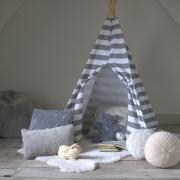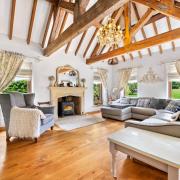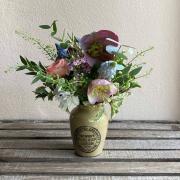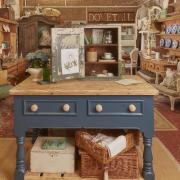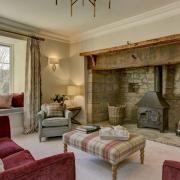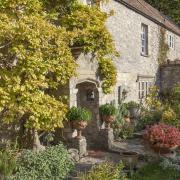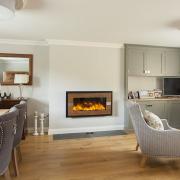Victoria Jenkins steps through the doors of a house with more than 400 years of history behind it

This beautiful stone-built building - with a rare Grade 2 * listing - dates all the way back to 1549 when two local yeomen paid £126 to found Ilminster’s first grammar school.
Of course in those days it was exclusively for boys, to teach them Latin and religion for a possible future in the Church, and it is a story typical of how most of the old country grammar schools began, all those centuries ago. Latin in any case was still widely used in business and the professions.
Standing close to St Mary’s, the 15th century minster church which gives its name to Ilminster, the school is thought to have started in one of the houses of the four chantry priests back then. Their work was to staff the four chantry altars attached to the church but, having a certain amount of free time and a good education, these priests often became teachers.
As for the two yeomen who founded the school, Humphrey Walron and Henry Greynfylde, they are still remembered today as their names were recorded in the patent rolls of that year, during the reign of Edward VI, the only legitimate surviving son of Henry VIII. Little is known of Greynfylde but Walron once lived at Sea Mill Farm, part of which still stands, at Sea just outside Ilminster. He died in 1580, unfortunately before he could see the humble beginnings of his school expand to the much larger building which was built in 1587.
“Amazingly all the governors’ records still exist - from 1549 through to 1971, which is when the school finally closed, so we know the very first schoolmaster was paid £7 a year,” says Peter Heath who now lives with his wife Gail and son Edward in the former grammar school. Or rather, in one of the four properties converted into dwellings in the year the school closed.
Peter and Gail bought their house in rather an unusual way by doing a part-exchange with the then owner.
“It wasn’t what we were looking for at all,” says Gail. “We actually wanted to be near Edward’s school in Colyton. But we agreed to come to Ilminster to see it - then loved it as soon as we walked in. The history was amazing and the period features were stunning – the ceilings are 14 feet high and there are tall skirting boards, huge stone mullion windows, ornate ceiling plasterwork and – most fascinating of all – graffiti scratched in the sitting room windows showing the children’s names of a class in the 1600s. So schoolboys haven’t changed!”

The Heath’s four bedroom home is three storeys high with original beams on display on the top floor and the original Tudor main door still fronting the building.
“Then in 1879 it became the girls’ grammar school and lasted until 1971,” says Gail. “And there are still many people in Ilminster who attended the school - or even taught here – and remember it fondly.” A great deal of information comes from R T Graham’s llminster Grammar School 1549-1949, A School History.
When the family moved in they discovered the developer had raised the floor in the main sitting/dining room so that the window sills were not so high and they could look out at the splendid view of the Minster. They believe the flooring in the hallway may be of old Victorian encaustic tiles but otherwise found the décor was too white and bare and in fact rather institutional.
“It was also slightly battered, as the previous owner had three sons,” says Gail. “So we’ve made a few changes. First we added more cabinetry in the kitchen, then we added a picture rail in the hallway to break up the rather high blank walls, added a cupboard under the stairs, then had the house redecorated throughout, including painting the floorboards in Edward’s room.”
“We believe the main part of our house was the old dining hall and that the headmaster used to have his study in a section of our sitting-dining room,” says Peter. “I wonder how many children have studied here during the 422 years it was a school. But it seems there may have been a school in Ilminster, possibly on this very spot, close to the church, even earlier than 1549. For a letter still exists from Robert Lawrence, rector of Wareham, writing to a merchant in Rouen in 1440, recalling the days when they were both school fellows together, boarding in Ilminster.”
With such a wealth of period features the Heaths decided their home had to be furnished in a suitably traditional manner.
“We had a lot of fun going round the antique shops looking for paintings and furniture and various accessories,” says Gail. “We found a lovely wooden carving in one place showing Elizabeth 1 signing the death warrant for Mary Queen of Scots. We’re told it probably dates from the 1600s but it does look very authentic on the landing.”

At the same time they bought their part of the old school the Heaths bought a much smaller place close to Edward’s school, which is where they had planned to be originally.
“And now we realize we have to spend most of our time close to Edward and hardly any time in Ilminster,” says Gail. “So very reluctantly we’ve decided to sell this lovely old house. We’ve been custodians of it for a relatively short time and we do love it so much but sadly we must move on.”
No 3 Church Walk, Ilminster, is for sale through Orchards Estates - 01935 277977 or 01460 477977.




